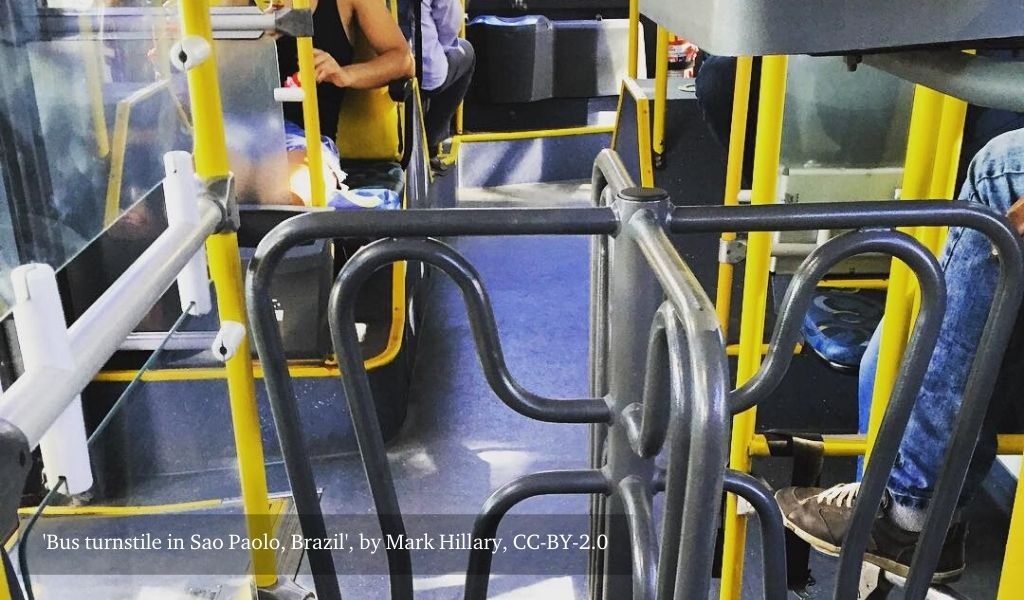In Brazil, 85 per cent of the nation’s population live in urban areas and 86 per cent of public transport is made by bus. This makes urban buses an important topic for Brazil’s development – especially in the context of notions of civil, political and social rights to the city.

Brazil’s urban buses, which are mainly operated by private companies, all have turnstiles that regulate passenger entrance and numbers. In several Brazilian cities the turnstile is located at the front of the bus, separating passengers who are entitled to some gratuities (elderly, disabled, etc.) from other passengers. There are too many stories of embarrassment and difficulties when trying to use the turnstiles. This has been exacerbated in recent years as turnstiles have become increasingly tall and narrow. In Chapecó, a 64-year-old woman was for 30 minutes stuck in a bus turnstile. In Rio Grande do Sul the Brazilian Justice ordered a bus company to pay $750 dollars compensation to an obese passenger who tried to force her way through a narrow turnstile. In Mauá, a 42-year-old caregiver was trapped in a turnstile and said she felt ‘rubbish’ in the face of such humiliation. In Recife, users of the Brazillian Bus Rapid Transit (BRT) frequently complain of ‘embarrassing turnstiles’.
Public transport and right to the city
The function of public transport is to ensure the comings and goings of people with dignity and comfort, operationalizing the right to transport but also ensuring access to the city. In an ideal world, there should not be an obstacle between you and your right. Therefore, limitations on the exercise of rights are limitations on the notion of citizenship itself.
In this context, the implementation of bus turnstiles (of the type typically used on Brazilian buses) is only permissible from the point of view of profit. From the point of view of citizenship, they are completely inadmissible. What is implied in the relationship between the state and the private sector for the operationalization of public transport is that the service must be provided with quality, within parameters established by the state itself, to provide comfort, security, accessibility and mobility to citizens in the city, solely and exclusively against the provision of a tariff (which must also be regulated by the state). Thus, the only admissible requirement for bus access is the payment of the fare, as well as the fulfilment of the eligibility criteria for free-of-charge transport for specific groups of people such as the elderly, students, and people with disabilities. Any other requirement beyond this is abusive.
Different solutions around the world
The issue of tariff avoidance is a problem for many cities, but the use of physical barriers does not necessarily help. Recent studies indicate that the removal of such barriers does not lead to an increase in tariff avoidance. The fare evasion rate in Berlin, for example, is between 3 and 5 per cent of total trips (without turnstiles), while in London (where the Oyster Card Contactless was introduced more than ten years ago) tariff evasion is around 6 per cent despite the use of barriers and turnstiles.
The guarantee of payment can be achieved in different ways. In Berlin, where there are no barriers to accessing trains, travellers are required to ‘validate’ their ticket on one of the available machines before boarding. Anyone who forgets to do so is subject to a fine of €60. In Oslo, barriers for train, tram and bus passengers were removed about a decade ago. The result has been increased efficiency, punctuality and customer satisfaction – all while keeping the level of fare evasion stable. By banning turnstiles, the city’s public transport agencies emphasized ease of access in the first place.
In Europe, the so-called ‘proof of payment’ has been in operation since the 1960s, in which inspectors randomly request proof of payment from passengers. In the United States, this has been happening since the 1990s. Authorities in San Francisco, California, even report that they have seen a reduction in tariff avoidance. They also pointed out that a barrier-free system is safer, mainly because bottlenecks are less likely during peak hours.
More radically, Estonia announced last year free-of-charge travel on all modes of public transport. In the same way, Luxembourg now offers free public transport to solve its congestion problem and to mitigate the effects of global warming.
Conversly, Brazil is making life more difficult for public transport users. To stimulate the use of public transport and advocate for the use of turnstiles is completely antagonistic and takes us further away from better cities and full citizenship.
Rafael S. F. Sales is based at the Federal University of Paraíba in Brazil. He is an IDS Visiting Fellow with the Cities and Power and Popular Politics Clusters.
